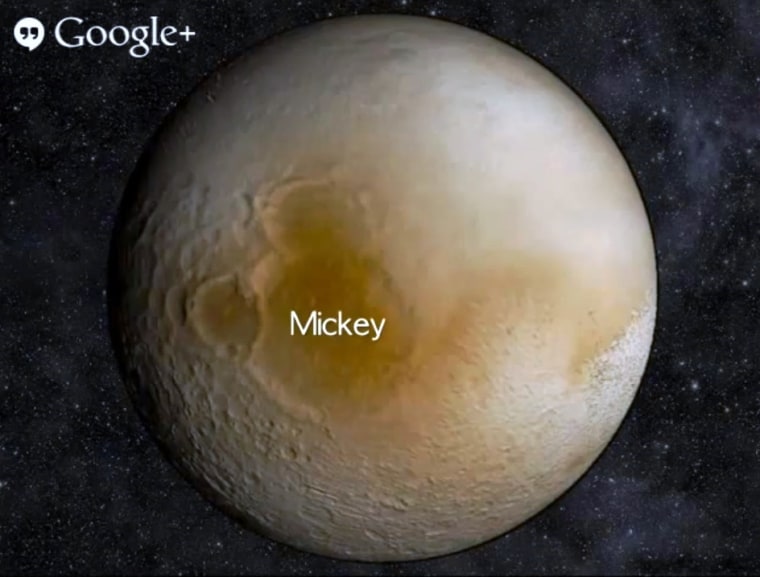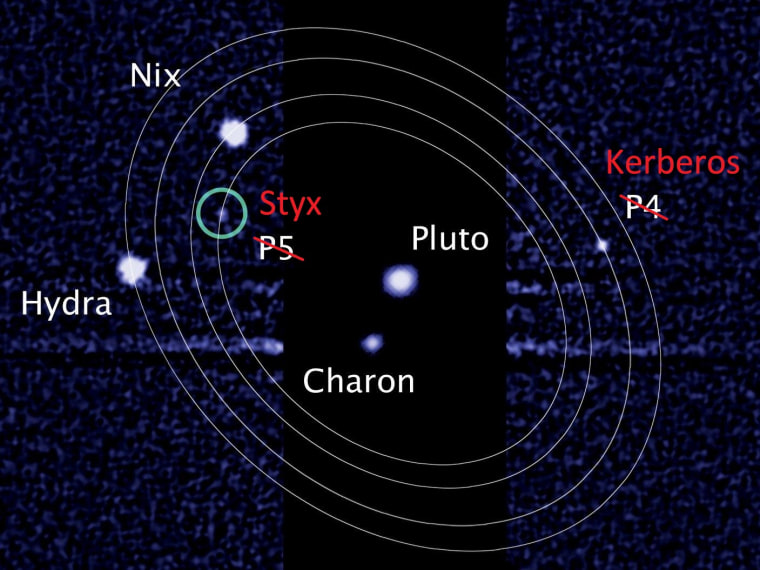The International Astronomical Union didn't make it so. Vulcan may have been the people's choice for a Plutonian moon, but instead, the IAU went with Kerberos and Styx as the official names for Pluto's fourth and fifth moons.
The names for the satellites formerly known as P4 and P5 were announced Tuesday by the IAU, and by the scientists who discovered the moons in 2011 and 2012, respectively.
Tiny ice worlds
The discovery team, led by SETI Institute planetary scientist Mark Showalter, detected the tiny moons during a Hubble Space Telescope project to prepare for a Pluto flyby. Showalter and his colleagues want to make sure that NASA's New Horizons probe doesn't run into anything when it zips past the icy dwarf planet and its moons in 2015.
Kerberos (P4) is thought to be 8 to 21 miles (13 to 34 kilometers) across, orbiting Pluto at a distance of about 37,000 miles (59,000 kilometers). Styx (P5) is a bit smaller and closer-in: 6 to 16 miles (10 to 25 kilometers) wide, and 26,000 miles (42,000 kilometers) away.
Pluto's moons are traditionally named after Greek or Roman mythological figures with a connection to the underworld. The largest moon, Charon, is named after the ferryman of the dead. Two other moons, Nix and Hydra, are named after the goddess of the night and a many-headed monster.
By that standard, Kerberos and Styx fill the bill: Styx is a river at the edge of the underworld, while Kerberos is the three-headed dog that stands guard at the gates of Hades, just beyond the Styx. The moon's discoverers went with the Greek spelling of the canine's name, because there was already an asteroid named Cerberus.
What about Vulcan?
Kerberos (spelled "Cerberus") and Styx rated No. 2 and No. 3 on a list of favorite names resulting from Showalter's "Pluto Rocks" online contest in February. But Vulcan was No. 1 by a wide margin, thanks in part to a strong endorsement from William Shatner, who played Captain James T. Kirk on the original "Star Trek" TV show. As any Trek fan knows, Vulcan is the home planet of Mr. Spock, who was Kirk's eyebrow-arching science officer on the show.
Leonard Nimoy, who played the role of Spock, backed the idea as well. "'Vulcan' is the logical choice," he observed in a tweet.
The IAU disagreed. Vulcan was rejected because the name has already been used in astronomy, initially to refer to a hypothetical planet inside Mercury's orbit. "Although this planet was found not to exist, the term 'vulcanoid' remains attached to any asteroid existing inside the orbit of Mercury," the IAU said in its statement. What's more, the mythological Vulcan (the Roman god of fire and volcanoes) was not closely associated with Pluto or the underworld.
Showalter said Vulcan got a fair hearing during weeks of deliberations. "I am grateful to the IAU for giving such careful consideration to our suggestions," he said in the SETI Institute's statement.
Do you think the IAU made the right choice? Or is this one more item to add to the list of Plutonian grievances? Feel free to weigh in with your comments below.
Update for 1 p.m. ET July 2: In a Google+ Hangout to announce the names, Showalter said he was "a little disappointed" to see Vulcan lose out. But "Star Trek" fans may still have something to celebrate when New Horizons gets an up-close look at Pluto in 2015.
Showalter said there'll be lots of surface features to name once they show up in detailed imagery — perhaps a Mount Sisyphus, or Oedipus Mons and Euridice Mons, or Elysian Field. He suggested that craters could be named after "Star Trek" characters such as Spock, Sulu, Kirk and McCoy.

Even Disney characters could be immortalized: "I'm hoping that someday Pluto will give us a place where we can put the name 'Mickey' as well."
More than 450,000 people voted in the "Pluto Rocks" contest, and Showalter said he'd recommend the exercise for anyone who has some moons to name. " I had a blast," he said. "It was just such a gratifying thing. ... It kind of restored my faith in humanity."
But Showalter wouldn't commit himself to running another moon-naming contest for Pluto. The discovery team now has tens of thousands of suggestions left over from the contest, just in case more moons show up when New Horizons flies by. And besides, Showalter said, "it's dangerous to count your moons before they're hatched."
Update for 1:25 p.m. ET July 2: The wrath of Shatner was quick in coming. His Twitter account issued protests: "Star Trek fans have had it rough. First JJ [Abrams, director for the latest "Trek" reboot] blows up Vulcan and now SETI finds a loophole to deny it from coming back! ... Who'd ever thought I'd be betrayed by geeks and nerds."
Shatner told Wired that this isn't over: "I’m going to lead a revolt," he was quoted as saying. "Pluto is so big and cold that it deserved to have a hot little rock running around it, named Vulcan — for fire."
More about Pluto and its moons:
Alan Boyle is NBCNews.com's science editor. Connect with the Cosmic Log community by "liking" the NBC News Science Facebook page, following@b0yle on Twitter and adding +Alan Boyle to your Google+ presence. To keep up with Cosmic Log as well as NBCNews.com's other stories about science and space, sign up for the Tech & Science newsletter, delivered to your email in-box every weekday. You can also check out "The Case for Pluto," my book about the controversial dwarf planet and the search for new worlds.
